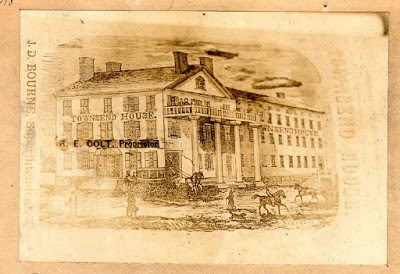Before Dr. Robert Ritchie McMeens enlisted for
military service in 1861 as a surgeon in the Third Ohio Infantry during the
Civil War, he was in private practice as a physician in Sandusky, Ohio for over
ten years.
The account book of Dr. McMeens, which covers the period from July 18, 1858 to April 25, 1861, is now in the historical files of
the Sandusky Library Archives Research Center.
At the bottom of page 1 in the account book is a
listing for O. Follett, most likely publisher Oran Follett, who saw Dr. McMeens
in July of 1858. Mr. Follett’s bill was thirty cents.
Someone from the Rush Sloane family saw Dr. McMeens in
September of 1858. The bill was $1.50. It appears that the patients may have
been Mr. Sloane’s son and wife.
Page 454 is the last page of the account book, dated
April 25, 1861. The name of prominent Sandusky businessman W.T. West appears
twice on this page. His fees were $1.50 and $2.00.
Sadly, Dr. McMeens died while in military service
during the Civil War. The Firelands
Pioneer of January 1888 contains an article about his death.
Within the article is a reprint of a letter which George G. Shumard, M.D. wrote
to Ohio Governor David Tod:
To
His Excellency, Gov. Tod, Ohio:
SIR:—It is with feelings of the deepest regret that I
have to announce the death of Surgeon R. R. McMeens of the Third Reg., Ohio
Vol. Army, which occurred suddenly at Perryville, Ky., on the night of the 30th
inst. Surgeon McMeens was among the first to offer his services to his country
after the breaking out of the rebellion. Entering the three months service as a
regimental surgeon, he was immediately after ordered to Camp Dennison, where
his gentlemanly deportment and great professional skill soon won for him the
esteem and confidence of his brother officers, at whose request he was
appointed Medical Director of the post; all the arduous duties of which office
he performed in such a manner as to win for him the warmest commendations of
the Surgeon General of the State. From that time until the period of his death,
he has continued in active service, filling many important positions in the
medical department of the army. Shortly before the battle of Perryville, he was
appointed Medical Director to the troops under the command of the lamented
Jackson, and after having participated actively in the battle, was detailed to
assist in taking care of the wounded at Perryville, in which position his
kindness of heart, sound judgment, and great professional skill, enabled him to
contribute very largely toward the relief of our suffering soldiers. He has
fallen while nobly working at his post; although suffering greatly from
disease, he refused to abandon his work, and performed several important
surgical operations only a few hours before his death. In his death the army
has lost a kind-hearted, faithful and efficient officer; the country a pure
patriot, and the medical profession one of its brightest ornaments. I am, sir,
respectfully, your obedient servant, GEORGE G. SHUMARD, M. D., Medical Director
Danville District.
 In this letter, Judge Samuel Caldwell of Sandusky has invited Samuel Butler and his wife Clara to his home for Thanksgiving dinner. (We know pumpkin pie was on the menu!) The date of the letter is November 23, 1846, nearly twenty years before the national holiday was observed. (It is also interesting to note that even then Thanksgiving was celebrated on a Thursday in November -- nobody seems to know for sure why this day was chosen.)
In this letter, Judge Samuel Caldwell of Sandusky has invited Samuel Butler and his wife Clara to his home for Thanksgiving dinner. (We know pumpkin pie was on the menu!) The date of the letter is November 23, 1846, nearly twenty years before the national holiday was observed. (It is also interesting to note that even then Thanksgiving was celebrated on a Thursday in November -- nobody seems to know for sure why this day was chosen.) The second letter is from Eliza Follett, the wife of Oran Follett, requesting contributions from local residents to provide Thanksgiving food to the wives and children of soldiers serving in the Civil War. Mrs. Follett was very active in community service and charitable work, as can be inferred from this letter.
The second letter is from Eliza Follett, the wife of Oran Follett, requesting contributions from local residents to provide Thanksgiving food to the wives and children of soldiers serving in the Civil War. Mrs. Follett was very active in community service and charitable work, as can be inferred from this letter.
 this blog
this blog




















































